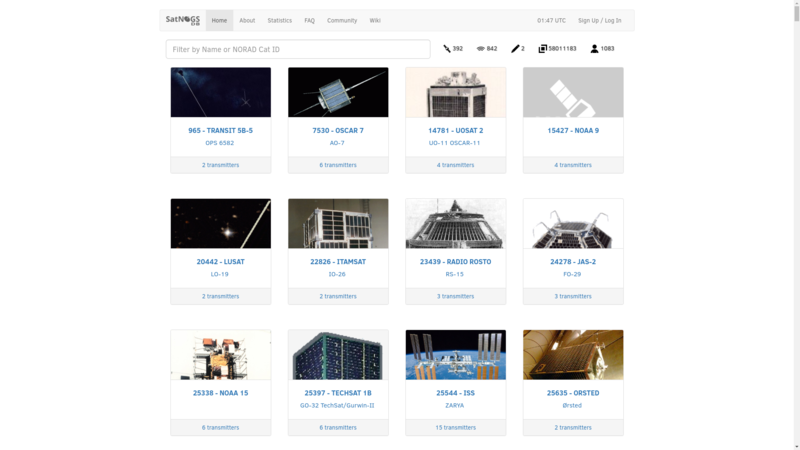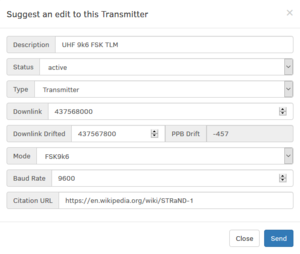SatNOGS DB
Introduction
SatNOGS DB is an effort to create a holistic, unified, global transmitter database for all satellite transmitters. You can export the data or even connect your application using our API. It's part of the SatNOGS project.
Data
The DB is open to everyone. Anyone is able to submit suggestions or use the existing Transmitters. All data are public and freely under the Creative Commons Atribution-Share Alike license.
Contribute
Adding Satellites
If you are a moderator you can add new satellites on the DB. For that follow the instructions:
- Log in to db.satnogs.org
- Navigate to https://db.satnogs.org/admin (if you are seeing a login screen, you are either not logged in to db.satnogs.org, or don't have moderator permissions)
- Click on Base::Satellite Add button
- Complete the information to the best of your knowledge. Norad ID and Name are mandatory. Add multiple names on the "Names" field.
- Click Save and you are done!
- You can now move on to the next steps: suggesting and approving transmitters for this satellite.
Note: this process may change in the future; see the Gitlab issues list for details.
Suggesting transmitters
We rely on crowd-sourced information to keep our transmitter details up to date. Anyone with a SatNOGS login can submit transmitter details. Moderators are notified and approve submissions frequently.
- Description: This is the name that will appear for this transmitter across DB, Network, and API users. Please use the following notations
- Band, for instance VHF, or for a transceiver, MODE U/V
- Baud (if applicable), in the format 9k6 for 9600
- Mode, for instance FSK
- Rough type description, ie TLM for "telemetry", or "FM Transponder" for repeater
- Examples
- UHF 9k6 FSK TLM
- MODE U/V FM Transceiver
- VHF CW TLM
- Status
- Active: alive and well
- Inactive: not functional or powered down
- Invalid: this is a legacy transmitter that should be hidden from UI
- Type
- Transmitter: one-way downlink (telemetry)
- Transceiver: repeats an uplinked signal intact
- Transponder: interacts with an uplinked signal or downlinks after signal modification
- Downlink: Published frequency, in Hz
- Downlink Drifted: Observed frequency, or what frequency should be used to properly tune (with doppler correction). In most cases this should be the same as the Downlink frequency. This field must be entered even if there is no drift.
- Mode: The modulation mode for this transmitter
- Baud rate: the baud rate, if applicable. If this is a CW beacon, use WPM
- Citation URL: a URL to link to in providing the details for your suggestion.
Approving transmitters
If you are a moderator you can approved suggestions for transmitters. For that follow the instructions:
- Log in to db.satnogs.org
- Navigate to https://db.satnogs.org/admin (if you are seeing a login screen, you are either not logged in to db.satnogs.org, or don't have moderator permissions)
- Click on Base::Suggestions
- Click on the suggestion you want to review and carefully check the data, especially the citation URL
- When you are ready to approve or reject the suggestion, go back to the full list of suggestions
- Select the suggestions you want to act upon and from the drop down above either approve them or reject them
- You are done!
Note: this process may change in the future; see the Gitlab issues list for details.
Coding
Fluent in Python and/or JS? We need you to help with the satnogs-db web application! Take a look at our source code, or visit our issues tracker to start filling bugs, feature requests or code fixes for existing ones.
API
The SatNOGS DB API is available to anyone at https://db.satnogs.org/api/ More docs to come....
Documentation & Installation
You can find documentation and installation instructions about the project in our Read the Docs instance.

